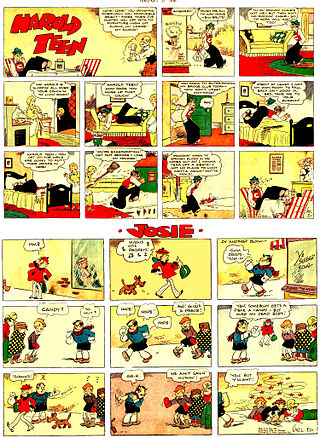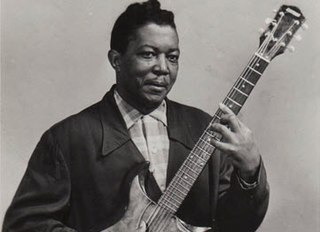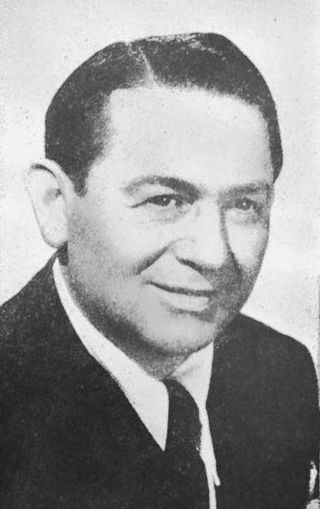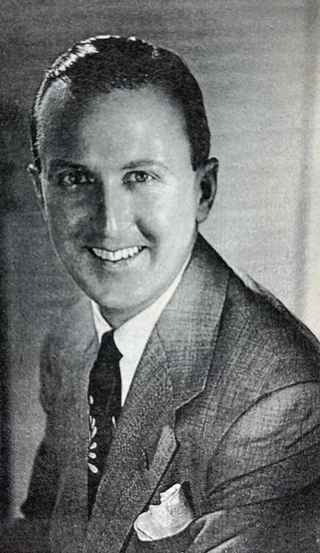
William James "Count" Basie was an American jazz pianist, organist, bandleader, and composer. In 1935, he formed the Count Basie Orchestra, and in 1936 took them to Chicago for a long engagement and their first recording. He led the group for almost 50 years, creating innovations like the use of two "split" tenor saxophones, emphasizing the rhythm section, riffing with a big band, using arrangers to broaden their sound, and others. Many musicians came to prominence under his direction, including the tenor saxophonists Lester Young and Herschel Evans, the guitarist Freddie Green, trumpeters Buck Clayton and Harry "Sweets" Edison, plunger trombonist Al Grey, and singers Jimmy Rushing, Helen Humes, Thelma Carpenter, and Joe Williams.
Swing music is a style of jazz that developed in the United States during the late 1920s and early '30s. It became nationally popular from the mid-1930s. The name derived from its emphasis on the off-beat, or nominally weaker beat. Swing bands usually featured soloists who would improvise on the melody over the arrangement. The danceable swing style of big bands and bandleaders such as Benny Goodman was the dominant form of American popular music from 1935 to 1946, known as the swing era, when people were dancing the Lindy Hop. The verb "to swing" is also used as a term of praise for playing that has a strong groove or drive. Musicians of the swing era include Duke Ellington, Benny Goodman, Count Basie, Cab Calloway, Jimmy Dorsey, Tommy Dorsey, Woody Herman, Harry James, Lionel Hampton, Glenn Miller, Artie Shaw and Django Reinhardt.

Ben Pollack was an American drummer and bandleader from the mid-1920s through the swing era. His eye for talent led him to employ musicians such as Benny Goodman, Jack Teagarden, Glenn Miller, Jimmy McPartland, and Harry James. This ability earned him the nickname the "Father of Swing".
Knowles Fred Rose was an American musician, Hall of Fame songwriter, and music publishing executive.
A nighthawk is a nocturnal bird.

Harold Teen is a discontinued, long-running American comic strip written and drawn by Carl Ed. Publisher Joseph Medill Patterson may have suggested and certainly approved the strip's concept, loosely based on Booth Tarkington's successful novel Seventeen. The strip ran from 1919 to 1959. Asked in the late 1930s why he had started the strip, Ed answered, "Twenty years ago, there was no comic strip on adolescence. I thought every well-balanced comic sheet should have one."

Robert Lee McCollum was an American blues musician who played and recorded under the pseudonyms Robert Lee McCoy and Robert Nighthawk. He was the father of the blues musician Sam Carr. Nighthawk was inducted into the Blues Hall of Fame in 1983.

Kansas City jazz is a style of jazz that developed in Kansas City, Missouri during the 1920s and 1930s, which marked the transition from the structured big band style to the much more improvisational style of bebop. The hard-swinging, bluesy transition style is bracketed by Count Basie, who in 1929 signed with Bennie Moten's Kansas City Orchestra, and Kansas City native Charlie Parker, who ushered in the bebop style in America. It has been said that while New Orleans was the birthplace of jazz, "America's music" grew up in Kansas City.

Vince Giordano is an American saxophonist and leader of the New York-based Nighthawks Orchestra. He specializes in jazz of the 1920s and 1930s and his primary instrument is the bass saxophone. Vince Giordano and the Nighthawks have played on television and film soundtracks, including the HBO series Boardwalk Empire and Woody Allen's musical comedy film Everyone Says I Love You.

Jan Garber was an American violinist and jazz bandleader.
Territory bands were dance bands that crisscrossed specific regions of the United States from the 1920s through the 1960s. Beginning in the 1920s, the bands typically had 8 to 12 musicians. These bands typically played one-nighters, six or seven nights a week at venues like VFW halls, Elks Lodges, Lions Clubs, hotel ballrooms, and the like. Francis Davis, jazz critic for The Village Voice, likened territory bands to "the Top 40 cover bands of their day, typically relying on stock arrangements of other ensembles' hits." He said, "many historians give much credit to territory bands for popularizing modern ballroom dancing that began during the World War I era with the influence of Vernon and Irene Castle."

A big band remote was a remote broadcast, common on radio during the 1930s and 1940s, involving a coast-to-coast live transmission of a big band.
Joseph L. Sanders was an American jazz pianist, singer, and band leader associated with Kansas City jazz for most of his career.
The Blackhawk was a restaurant in the Chicago Loop from 1920 to 1984. It served a menu of American cuisine, notably prime rib and a signature "spinning salad bowl", and was, in the early part of its history a nationally known entertainment venue for Big Band music. Its legacy continued until 2009 at Don Roth's Blackhawk in Wheeling, Illinois.

"Flamin' Mamie" is a 1925 jazz classic composed by Paul Whiteman and Fred Rose.
Roger A. Graham was an American lyricist, composer, singer, and music publisher who flourished from 1906 to 1920 — a period that included World War I, the golden age of Tin Pan Alley, the dawn of the Jazz Age (circa 1914), and the silent film era. Graham was a proponent of vaudeville and burlesque songs. But as a lyricist and publisher, Graham is most remembered for having been an exponent of blues songs.
Orville Knapp was an American dance bandleader born in Kansas City, Missouri. He was the brother of Evalyn Knapp.

Charles LaVere Johnson, better known as Charlie LaVere was an American jazz pianist, vocalist, bandleader, and composer. He is best known for his extensive work with arranger Gordon Jenkins, including the 1948 million seller “Maybe You’ll Be There”, his own dixie jazz group LaVere's Chicago Loopers, and his later work for Disneyland's Golden Horseshoe Revue, for which he composed the music and led the band performances from 1955 to 1959, and which would go on to become the longest running stage show in the history of show business, running for over 31 years and over 39,000 performances.











